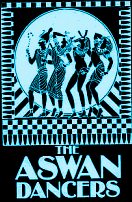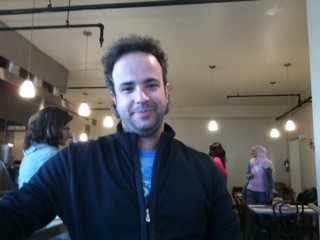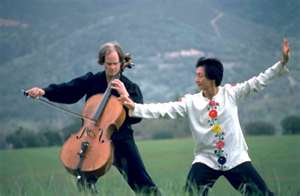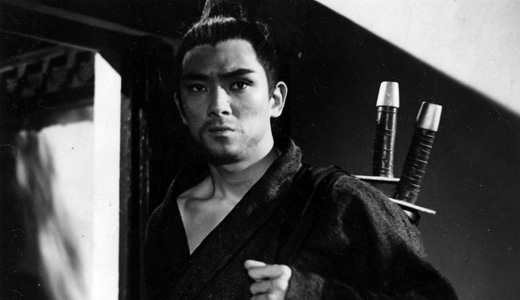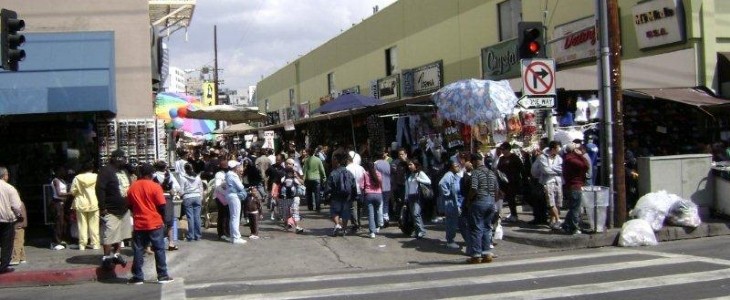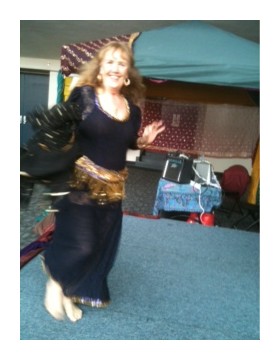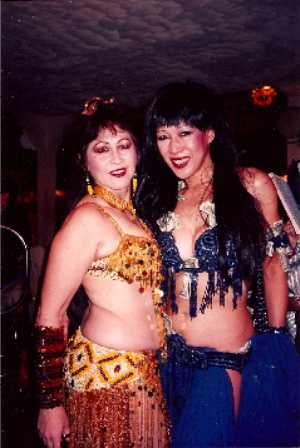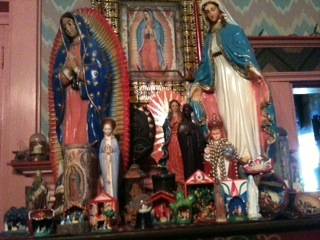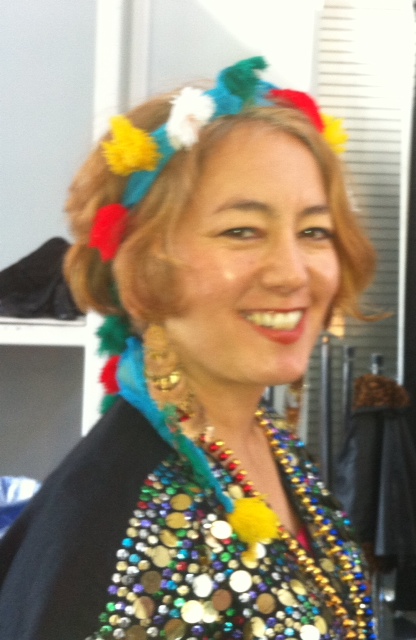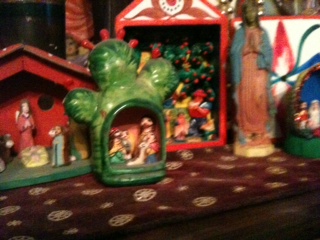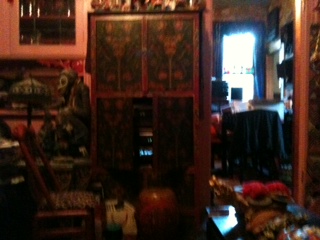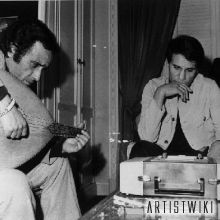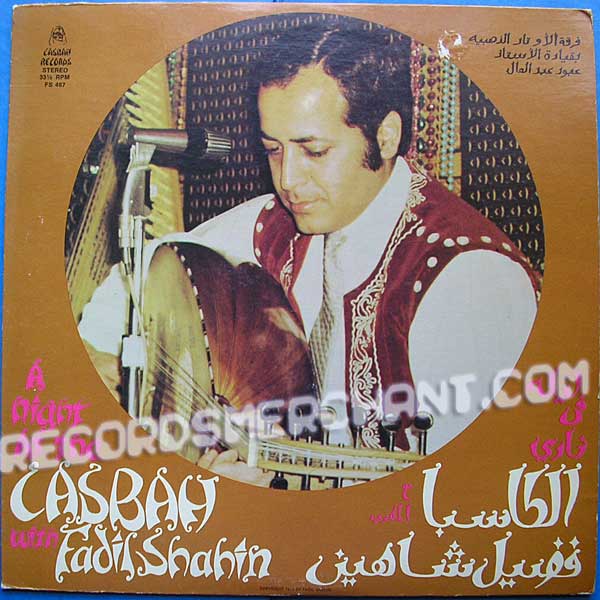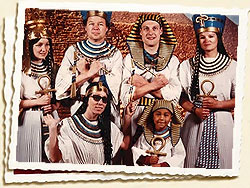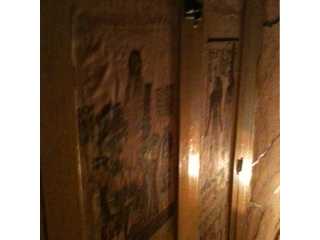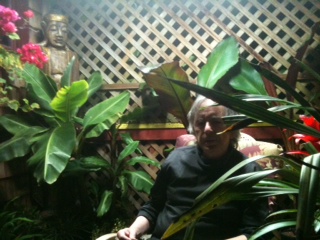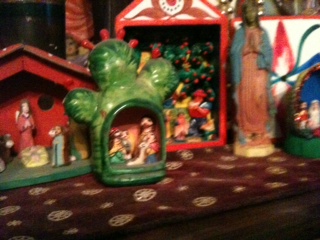Ba Olek Eh - Amina's Daily Blog
(tell you what)
January 17, 2012
Keeping the tradition
It seems that since the demise of the "Big Three",
Om, Farid and Abdel
Halim, that with an occasional important piece composed by Mohamed
Abdel Wehab (1899-1991) or Baligh Hamdi
(1939-1993). there really hasn't been much coming out of Cairo in the
way of significant music for a very long time...like maybe for 20 or so
years.
Most of the music we use and find in CDs really is from a 40-year span
of time between 1950 to about 1990. Usually if we hear a great new piece
it is really a cover of a song from that earlier time span, or quite possibly
even before 1950.

The only major singer doing important music after 1990 seems to be Warda
(1939 -) and because of health reasons, she seems to have dropped off
the map. Of course there are others, impresarios and producers, who have
tried to promote new singers as the new Om or X. However none of these
singers really could compete or hold their own long enough to make a lasting
impression.
Although I'm talking about lasting, important and epic type pieces, even
in the Egyptian folkloric realm, Saidi musician Metqal
Qanawi's (1929-2004) creations from the 1970's still hold the standard
for excellence in folkloric song.
What's left? A lot of really nice voices, both male and female, that either
sing short little ditties, often times very globalized, or that cover
the wonderful music and songs from the past.
Plus what else is left on our Belly Dance CDs is the mergence (magensi).
And what is this? It's the opening musical composition for an Oriental
routine and is usually composed for a westernized choreography and now
it has become a piece to showcase the dancer rather than be a piece of
musical noteworthiness.
Usually today when people choose a mergence of importance, what do they
choose? Something from the 1970's or earlier such as Mashaal,
Sitt el Hosn, Princess, Raks Nagwa, Hani, Tammer Henna. So what
does this tell me? I don't think I need to explain except in the past;
maybe more thought was put into musical composition. Or could it be that
dancers' choreographies were not as formulaic as they are now? Who knows?
Maybe food for thought?
Could it be that besides losing all those wonderful composers/musicians
and singers who were the composers' and poets' inspiration, that the depressive
economic, conservative religious and repressive political climate of Egypt
had an influence - what's the opposite of influence? - on squashing the
creativity of these future artists?
There are two films out. "Microphone"
and "The Noise of Cairo". I have
seen "Microphone"
(2011) which was filmed prior to the revolution and the film shows the
problems and discontent of the times.
""Microphone" is an exceptional film that highlights a
people's defiance through music and art and features a stunning Arabic
rock and rap soundtrack that reflects an incoming tide of change from
a disenfranchised people."
The other, "The Noise of Cairo" (2011), I have only seen
the trailer.
“The Noise of Cairo” is a cinematic adventure, following the
interplay between art and the revolution in Egypt. Protest of any kind
was punished violently in pre-revolutionary Egypt and artistic expression
was considered nothing but a threat to the status quo. But since the fall
of the Mubarak dictatorship, the art scene
in Cairo is flourishing once again."
Both of these films are products of the January 25 revolution and show
a music scene that combines both the vernacular and the international
language of music to form a new language. In this music the guitar seems
to have an important place - as in the protest songs of Joan
Baez from the 1960's and 1970's. So "the art scene in Cairo
is flourishing once again." But how is it flourishing and where is
it going? I wonder.
I guess art evolves and changes and change is good. ?? I guess I am stuck
in the past. I like to see innovation but I also like to see a thread
that comes from within the culture and not from another culture that wants
to embrace globalization. I know this is the music being broadcast and
is the music that we are getting here in the West. There must be more
traditional music being composed or maybe the changing climate isn't conducive
to keeping the tradition.
But I think and hope that the real music of the people, the downtrodden,
the Shaabi is still there - yes, changing to suit the times, yet preserving
the culture as they know it. Home
January 16, 2012
Practice and learning technique
I spent the afternoon working on my front stairs. Last
summer I had the house touched up but wanted to redo the stairs myself.
But laziness was a factor and repainting the stairs became just a few
words on my "to do" list. So today I decided to just get out
there in the freezing cold and do it. Well, at least I started on one
of the colors. In reality it is quite fun and meditative to do. I really
like painting - just don't like the prep and clean up. I guess, who does?
Anyway, while out there my meditation was about the Pasha
Band and how to organize our practice and make the most of our
time together. Since we all are part of Aswat,
we will see each other a lot at Aswat practice. And since this will be
at least twice a week, no one really has the spare time for more and separate
band practice, so I need to really organize our rehearsal. We just added
two new members to our group - Chakib, oud
and Amr, bass. This is pretty exciting. Of
course more members means that soon we will be too big to play anywhere.
Well, we'll see where this goes.
Class was fun tonight. I tried to incorporate what Outi
taught and what Fatma (Akef) taught with
the Eastern methodology of "Embrace Tiger Return
to Mountain". All of this is about internalizing the movements.
I think I will review that movie "36 Chambers
of Shaolin" for more ideas. Also I think I should make watching
"Drunken Master" starring Jackie
Chan as required viewing. I wonder if I have a copy of that DVD.
I don't think so. OK, Amazon, yet another DVD for me to purchase.
I know it seems ridiculous to encourage watching Kung Fu movies when I
should be telling the dancers to watch Soheir
or Fifi or Dina.
But I really think that if people understand the essence of it they would
know what I mean. According to Wikipedia: kung fu means "hard work",
and refers to one's expertise in any skill achieved through hard work
and practice, not necessarily martial. It is about accomplishment arrived
at by great effort.
"Originally, to practice kung fu did not just mean to practice Chinese
martial arts. Instead, it referred to the process of one's training -
the strengthening of the body and the mind, the learning and the perfection
of one's skills - rather than to what was being trained. It refers to
excellence achieved through long practice in any endeavor. You can say
that a person's kung fu is good in cooking, or that someone has kung fu
in calligraphy; saying that a person possesses kung fu in an area implies
skill in that area, which they have worked hard to develop. Someone with
"bad kung fu" simply has not put enough time and effort into
training, or seems to lack the motivation to do so."
Therefore, when I refer to watching certain Kung Fu movies, it's really
about the hard work, which comes from making the movements so natural
because they have become a way of life. Home
January 15, 2012
Aswat and Pachamama
Aswat's official
spring season began today with a brunch meeting at the Melody
Cafe on Mission Street. This is the cafe that Loay's
friend Essam opened a short time ago. About
35 of us were there to enjoy his hospitality and food. Arabic food, of
course! And waaaay too much of it. There were so many different tastes
that I didn't really get to taste all because I ate too much the first
round. If I had known that after we all served ourselves, that more and
different items waiting in platters were on the tables, I certainly would
have rationed the first round. There were lots of new and interesting
(to me) dishes.
Essam is from Kuwait so this was not standard Arabic fare and one of my favorites was something that included dates and was not a dessert. But later there were also great desserts including kanafeh. Kanafeh is a special warm pastry treat made of sweet cheese and filo colored a day-glo orange smothered in sweet syrup. Sometimes it is a chartreuse green color. Essam told me that the color comes from food coloring. I wonder why it's always a fluorescent color. The green or orange colors are really not that palatable looking, however, maybe like Pavlov's dog; it triggers the desire to consume. (If bought in a bakery or restaurant this dessert, kanafeh, is always the highest priced and considered special.)
Nabila arranged a nice get-together and told
us of the up-coming events. The next event in a week or so will be a welcome
back party for Omar, our director arriving
from Jordan. The main subject of this event will of course be more food.
Oh yes, and music too!
Nabila wanted us to fill out questionnaires about our music and rehearsal
desires and requests for the coming season and to ensure that we all filled
out our questionnaire she promised each of us a present upon completion
of the form. Smart lady! In return for filling out the form we each received
a book, 2 CDs, some chocolates and a raffle ticket for a T-shirt. Husain
was one of the lucky winners of the T-shirts raffled and
Susu tried to con him out it telling him that it would fit her
better. We'll see.
Of course Aswat get-togethers always have to have music, so out came the
instruments. Husain started off the singing with the Abdel
Basit version of Adaweya's "Kulu
aala Kulu". Husain really did memorize Abdel Basit's arrangement.
This was lots of fun with the band singing or rather yelling the chorus
parts. Most of Aswat is too young or too musically conservative to even
know who Adaweya is. I guess we'll have to educate them. I wonder if Aswat
would ever agree to play Adaweya. That would be a first! Shaabi music
in a classical music choir. Well, I doubt it.
But after playing a few pop/Abdel Halim songs
and requisite Aswat type songs, we ended with Husain again singing Abdel
Basit's Kulu aala Kulu. I guess he really is lobbying for this song. The
second time around we had more Aswatees singing along. Maybe it'll grow
on them.
After the bonding party was over, I dropped Husain off and agreed to pick
him up in an hour and a half so we could go to Pachamama.
So about an hour and a half later I'm in front of Husain's house calling
him. No answer. I wait a minute and try again. This time he answers. He
doesn't even know who I am. Finally when he realizes who I am, he wonders
why I'm calling. Finally he (and I) realizes that he was sound asleep
and had forgotten about the world and Pachamama. So, after listening to
a couple of songs in my car he finally appears, refreshed, awake, caffeinated
and ready to start the night at Pachamama.
Tonight was one of those quiet nights. The place actually filled up but
it wasn't our usual party-like belly dance crowd. Yes, there were other
dancers to watch dancers, but it seemed more like date night. Even Essam
(from the Melody Cafe) who usually comes alone was with a date. Georges
and Tony had just come from playing at a birthday party in Arizona and
Tony seemed a little sleep deprived so he took quick catnaps on stage
between songs. It was pretty amazing to see him doze and then there he
was ready on the dum. It reminded me of how people sleep on the bus and
immediately jump up at their stop.
We had a nice lineup of dancers and outside of Judi and Rose, most of the other dancers were pretty new to our scene. I hope this is a good indication of this coming year. Of course I love seeing the familiar dancers but it sure is fun to have other dancers also. Everyone is welcome!!! Just contact me. I hope that 2012 will inspire other dancers and dance teachers to join us at Pachamama. Our next date at Pachamama will be our Valentine's Party on February 12. Home
January 14, 2012
BDUC is a month away
Today I spent some time trying to finalize my choices
of songs for teaching and performing at BDUC.
I think I finally chose them. I will perform two different shows and teach
one choreography. But now I'm not sure how much choreography I should
teach. I decided I would teach to Baed Anak
and choreograph only the first half and teach how to improvise to the
second half. Of course all this plus technique, musical breakdown and
a background on Om in just one short hour is pretty ambitious, but I'll
try.
I guess the next item on my agenda is to actually make up a choreography
and write it out. What I really need to do is to lock myself up in the
studio and work. But I've been pretty lazy lately. Or maybe it's just
that I live so many hours in the studio that when I'm not teaching I just
want a change of scenery. Well maybe I'll just get in my car with my CDs
and do a little car- eography. I used to do that a lot when I worked in
the East Bay and got in lots of "parking lot" type traffic jams.
But now I hardly work out of my house and when I do, it's only 10 minutes
away. That's not enough time to even think about being creative. I never
thought that not commuting would dampen my creative abilities. Maybe I
need to take a long solo drive to nowhere and see what happens. But with
gas prices the way they are, I probably should just discipline myself,
lock myself up and work. Work? I don't like thinking of dance as work.
Probably once I get going it won't be work at all. It just takes that
initial decision to start. OK, where's that book on procrastination. Gotta
get it out and put that to work. Home
Outi of Cairo
Tonight Monica sponsored Outi from Cairo in a melayya lef workshop. I knew of Outi because I had her two CDs and her first CD had a great Alexandrian song that I've used in perfomance several times. This song is one of my favorite songs. Of course I have a list a mile long of favorite songs but the other CD also included another top hit favorite song. It is a cover of Abdel Basit Hamouda's "Idiny Albak" (I sometimes call it "Andak Alby") and that song I have also used in performance many, many times. Quite coincidentally I performed both of those songs at BDUC over a span of 10 years. Yes, they are up there on my list of favorite songs. So I was curious to meet this woman who seemed to have the same taste in music as I do.
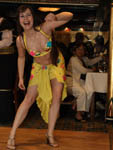



When she taught her class I found that we also shared the same philosophy about dancing with "props" and using a melayya is a prop. She seemed to not only have the Egyptian attitude in her dance but in her manner of teaching including how she vocalized and addressed the class. And hurray, she did NOT teach a choreography - what and how she taught, at least for me, was better. If I didn't know better, I would have sworn she was Egyptian. But then I remembered...most Westerners and non-Egyptians are better at teaching Egyptian dance, technique, attitude and feeling than the Egyptians are. The native born Egyptians seem to prefer teaching balleticized choreographies.Home
January 12, 2012
Cassettes in the purse

Today I received a present in the mail from Latifa who teaches Middle Eastern dance in Maryland. We met each other many years ago when we went on Morocco's Secret Egypt dance tour. On the dance tour we saw many top dance stars including Nagwa Fuad, Soheir Zaki, Shu Shu Amin and Nadia Hamdi. Yes, how great is that? It was so great that I actually went on Morocco's Secret Egypt dance tour twice. It was a very economical and convenient way to see more dancing than one could possibly imagine - seeing all this dancing crammed into a tour of less than two weeks.
Of course there was no Ahlan wa Sahlan then. Each of the above dancers performed in their own hotel or club venue and each dancer was part of a larger dance or entertainment revue. We got to experience the whole package and the different types of venues - from the 5 star hotels to the for sure not 5 star clubs on Pyramids Road. Today these clubs or hotel entertainments do not exist - some closed or burned down - or at least not in the scale as before. Those days are long gone. I feel blessed to have been there back then. And now with the new government in Egypt, I wonder what the future holds.
Each dancer performed with her own orchestra and although I had gone to Egypt to see the dancers, it was the musicians who really impressed me. They were that good! And I'm comparing them to incomparable dancers such as Soheir Zaki.
Well, my present in the mail was a package containing 5 CDs of music that was transferred from "cassette in the purse" recordings from that trip so long ago. I, too, had a purse and a cassette recorder; however the fidelity on my recordings was nothing to brag about. These CDs from Latifa and her husband David took me back to "the good ole days". The recordings are really quite good! And what is it about the live shows that make them so magical?
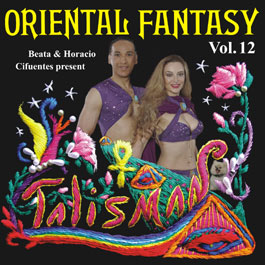
I have the CD "Talisman" from Horacio and Beata and the sound quality is more superior to most CDs and the tracks are great and have that Egyptian heavy on the duf sound, but it is still a CD with lots of tracks. These recordings I got from Latifa may not have the same superior studio quality fidelity but the sound is still great and what may be lacking in the division of tracking - included of course is the MC speaking and background noise between the music sets - is more than made up for by the excitement and urgency of a live show. I put one of the CDs in my player and there it was Shu Shu Amin in living color in my mind. So I just started dancing to the CD and felt as though I was part of that show way back when.
Somehow these "cassette in the purse" CDs are different and the music just makes me want to strut and dance differently. Quite possibly this is what I will be working on next Thursday in class Home
January 11, 2012
Embrace Tiger Return to Mountain
In the 70's my belly dance bible was a book called
"Embrace Tiger Return to Mountain" (1973). It was a book about the essence of Tai Chi written by Chungliang "Al" Huang.
In China, Al Huang studied martial arts and Peking
Opera. He was a Tai Chi master and educator and received the Gold
Medal Award from the Ministry of Education in the Republic of China. After
moving to the U.S. Al Huang embraced the lifestyle of the 70's in America
and in the U.S. he was also known as a dancer, performance artist and
spiritual leader. He truly was a product of the 70's hanging out with
Alan Watts, teaching at the Esalen lnstitute
and eventually establishing the Living Tao Foundation
in Oregon while he also performed with Bruce Lee
and as a dancer with Sammy Davis Jr. and
the "Rat Pack" and in the film
"Flower Drum Song".
I discovered this book because I was a Kung Fu movie groupie. This is
what I did on my days off from the Bagdad.
I would go with friends to Chinatown and non-stop watch Kung Fu movies
jumping up and down in the seats, screaming and yelling with excitement
all the while eating and spitting out peanuts and
crack seed with the rest of the audience. We all loved the movies
so much that we also studied various forms of Kung Fu or Tai Chi. I used
to study Yang style at the Chinatown YMCA from Master
Chen and would buy all the books I could on the subject. Kung Fu
and Tai Chi are not just martial arts, they are a way of life and they
are dances.
Because Al Huang was a Tai Chi master, performance artist and a dancer,
his book appealed to my sensiblities and helped me verbalize a lot of
what I was teaching. I felt - and still do - that his explanation of the
chi and how to use it was the same (and can be applied) in Middle Eastern
dance. Chi is the term for the universal energy that permeates everything
around us and applies to the energy inside our body as well as the outside.
In the book he also addresses the
Tan Tien which is the center from which all martial artists move when
they perform and is located about 2 and a half inches below the navel.
This is where I believe you need to connect with in order look "grounded".
He also talked of recycled energy. We should always dance giving the audience
our energy and then bringing it back to us. I could go on and on and on.
But if you are curious and feel so inclined, maybe you can click on the
links and you will get what I am trying to say. Me, myself, I'm feeling
energized just thinking about all of this and kicking myself for not pulling
out "Embrace Tiger Return to Mountain" and rereading it. I guess
I will. When I was teaching in the 70's I tried to make it required reading
for my classes. I think some of the girls actually did read it. I really
do think that it should be required reading to find out how to get that
"it". (Well I'm talking about the spiritual and physical "it"
of belly dance, not the cultural "it". For that, it's best to
live in that culture.)
So, why am I on this subject tonight? Well, I just watched a two hour
documentary on the history of Martial Arts in the cinema narrated by Samuel
Jackson. It was fantastic and brought back "keteer, keteer"
too many memories.
In the documentary they showed clips of all my heroes. I never really
ever had a "crush" on a movie star - maybe almost James
Dean, until I found "Jimmy" Wang
Yu. I don't know why, but he was MY HERO! I used to buy Chinese
movie magazines and bring them to my corner grocer, Warren,
and make him translate all the movie gossip - especially about
Wangers. That was my special name for Wang Yu.
Although he studied martial arts, Wang Yu was really just an actor (writer,
producer, director) but his film "The Chinese
Boxer" (1969) is credited as being the first Hong Kong martial
arts film that kick started the unarmed combat genre in the 1970's - think
Bruce Lee. My favorites of his films, though, were his sword fighting
films such as "The Golden Swallow"
with Cheng Pei Pei and "One-Armed
Swordsman" (1967) is considered to be a classic. He also acted
in "36th Chamber of Shaolin"
which is also considered to be one of the great kung fu classics. Wang
Yu was once the top paid martial arts actor until Bruce Lee broke the
record.
This documentary really inspired me. In it they (Samuel Jackson, various
Chinese directors and the actress Chen Pei Pei) ) repeatedly talked about
the dance and the rhythm in Kung Fu movements in the movies (they also
used clip examples).
Another favorite actor of mine was Alexander
Fu Sheng who also starred in a lot of the Shaolin series. He was considered
to be the next big star after Bruce Lee and he even bought and lived in
Bruce Lee's house, however he died a premature death at 28 as did Bruce
at 32. His funeral in Hong Kong was almost as large as Bruce's. Because
many of his films never made it to American DVD distribution he never
received the recognition he deserved here in the U.S. His old makeup cubicle
at Shaw Brothers Film Company features a
shrine constructed to appease his ghost which is said to haunt the back
lot. Home
January 10, 2012
Shopping
Just made my travel arrangements for
BDUC. Am really looking forward to this annual trek to Southern
California that I think is really an excuse to buy another purse or pair
of shoes. This trip I plan on going from LAX and taking the shuttle direct
to Santee Alley in the garment
district in L.A. In the 70's the wholesalers (from the surrounding garment
and fabric district) started selling overruns of clothing on the weekends
and soon it became the place to go to shop for deals.
OK, I just got rid of about 20 purses. Haven't gone through my shoes yet
but will before I go to BDUC. Then maybe I won't feel bad about supplementing
my wardrobe with new accessories. But does this mean that I have to sew
up all the fabrics that I bought last year before I get more fabric? I
did make use of most of the fabric I bought but still have yards to go.
The key is to go into the district with a plan. That really isn't how
I work and I wonder if I can practice self-control and not let whimsy
get in the way.
I remember going to the fabric district with Rose
one year and she loaded her car with what seemed like 70 lbs. of fabric.
Yes, she actually drove to BDUC so she could go to the fabric district
and fill her car to brimming with fabric. Well, every time I see Rose
it seems that she is wearing a beautiful new creation from that incredible
shopping excursion. Rose is scheduled to perform at Pachamama
this Sunday and at Al Masri the following
Sunday. I am sure that I'll be treated to at least one new creation.
Home
January 9, 2012
Drum class
I look forward to Monday night dance classes
because I really look forward my drum class after the second class. In
the class I get to do whatever I want and lately I've been working on
technique. The only thing better than me teaching this class would be
if Susu were teaching it. Since she's here
on Wednesdays and not Mondays, I teach this class. I just try to remember
how and what she teaches and I use the class for practice. As I mentioned
before I think I finally got the class going so that we don't have to
relearn the rhythms each week. We finally know them. Hurray! Now I can
concentrate on sound, technique, riffs and working on drum solos. Sometimes
we play along with a song and that is fun but me working on drum solos
without Susu is a real first for me. This is something I've always wanted
to be able to do but never felt good enough to do. This is a real challenge.
First we listen to a drum solo from a CD and I figure out the patterns.
Then we practice the patterns. Of course I figure out easy ways to do
them - not quite as many strokes or fancy fingering - but close enough.
Then we work on making the riffs sound clean. Finally for the end of class
we play what we practiced along with the CD. Of course we almost sound
pretty good playing along with the CD and we're still not fast enough
or clean sounding. Not anywhere near like Susu's
playing. But there's promise. Practice makes perfect. In our case,
maybe not perfect but better. Practice makes better.
Home
January 8, 2012
The Hangout - Just like yesterday
Last night on the way to Al Masri
I thought about all the hundreds of times I had driven that route and
why. So many years ago, 30 + years ago to be inexactly exact, every Sunday
evening was devoted to taking Egyptian Arabic language and singing from
Nicole Ibrahim who lived on Balboa and 42nd.
Some of the people in the class were also my friends and members of my
dance group, The Aswan Dancers. (Kathy
Trewin, Linda Grondahl and Marsha/Shamira)
We would meet at Nicole's and partake of conversational dialogs while
sipping tea and munching on goodies bought from the Arab grocer across
the street. Nicole felt that it was important to learn the language and
the song in the Egyptian way. This meant we needed to also learn and understand
Egyptian culture and hospitality.
Each week she gave us short dialogs to repeat and act out with each other.
The dialogs always included body language, lots of head slides, head bobbing
and hand and eye gestures. We learned what "ya aini" meant.
Literally it means "oh my eye", but oh, it means so much more!
And we learned all the hand, eye, head gestures that accompanied that
phrase and lots of other phrases. Nicole truly gave us a great introduction
to Egypt and Egyptian Arabic. Like parrots we memorized our little stories
- custom made dialogs for and about us about dancing, eating, purple cockroaches,
being late and accepting rides. Everything done and said needed to be
accompanied with an attitude and a gesture.
I think her best student was Linda.
Even today she is still spouting off little phrases that we learned in class so many years ago.
After Nicole and her husband bought a house and moved to the suburbs I
continued to travel the route from my house to Balboa and 42nd Ave. But
now it was to go to The Grapeleaf coincidentally
also on Balboa and 42nd Ave.
The Grapeleaf is now known as Al Masri. Sue
and Gabe owned the Grapeleaf. After they split up Sue maintained
ownership and later changed the name of the restaurant to Al Masri. Marsha/Shamira
worked at The Grapeleaf as a dancer and also as the bartender. Sue and
Gabe had started a live music night on Sundays - they were the first to
do this - and the various musicians in the area had their turns to perform
on Sunday nights and we dancers called The Grapeleaf our hangout.
We hung out there to dance or to watch our friends dance. I used to call
Sundays nights as the night of the recycled rubber dollar bills. As each
dancer would go out for tips, she would receive tons of money and then
in turn would use that money to tip the next dancer. It was kind of like
a dancers' savings association. She could take her money home with her,
but the next time time she would go to The Grapeleaf she would use all
her previous tip money to tip the dancers. Yes, money flew on Sunday nights
at The Grapeleaf, but it always came back.
Amina and Marsha/Shamira
I don't have too many pictures of Linda because she was always the official photographer.
So last night on my way to Al Masri my mind was full of fond memories
of Balboa and 42nd Ave. Because this was MaShuqa's night I wasn't sure
who would be there. A few of my dancers were going to be dancing also,
but they would be upstairs in the dressing room. I was alone and wondering
if I would end up sitting by myself. Well, I walked in the door and didn't
have to wonder too long. Sitting right by the stage area were Marsha and
Linda. Of course! If I had those kinds of memories
of this street, naturally they did too. Home
January 7, 2012
Dancing
This afternoon I got a phone call from
Samia
Nasser. We had lost contact for a number of years because she moved
to Las Vegas, but about 3 years ago she called me and we've managed to
catch up.
She now is in real estate but considers teaching dance on the side. I
think this is a good idea because she has so much to offer. She was by
far my dance role model more than any other dancer I ever met. I think
I mentioned before that I studied with Fatma Akef
(Naima Akef's sister). This I did, but I
never really wanted to dance like Fatma, I just wanted to learn her dance
movements.
I always really wanted to dance like Samia. To me she was the dancer that
lived inside me...the kind of dancer I was but could never let out. I
was always too shy, too inhibited. When she danced, it wasn't just the
movements, it wasn't the beauty or makeup or hair, it wasn't the costume
or the personality, it was the entire package. It was the way she was
able to translate the music, the song, the lyrics, with her entire body
and persona.
When she danced she was a star and the audience knew it. She was very
memorable. I'd like to quote something I wrote in gildedserpent.com
a number of years ago:
"When Samia danced it was magic. Samia was the dancer I dreamed of
becoming. Her hips did not belong to her body and her cleavage was outrageous.
Yousef would never have to tell her to pad her bras! I hoped one day to
be able to dance like Samia. She was the epitome of sex, virginity, naughtiness,
innocence, glamour and trash all rolled up into one hot Arabic dancing,
entertaining babe who claimed she was a virgin!"
Sometimes I would drive Samia home from work (we both worked at the Bagdad) and she would invite me up for tea and a bite to eat. Yes! This was heaven. She would feed me the greatest Iraqi dishes and then would play Om Kalthoum on the record player. She would then proceed to simultaneously translate the lyrics just as poetically as they must have been in Egyptian. I told her that she could get a job at the United Nations. She was that good and that fast. Sometimes I was able to coerce her to get up and dance for me. I would admire her dancing from a distance wishing a little of her magic would rub off on me. Now she tells me that she always wondered why I never asked her to teach me. I think it was because I knew she would do it for free and I never wanted to take advantage of her friendship.
Last week I danced at On Lok with Bianca.
Dancing at On Lok was a total no stress performance. On Lok is an old
folks facility and I usually dance there about twice a year. It's in North
Beach near all the cafes and Bianca and I make a day of it. We go early
for coffee and brunch, hit the streets and shop or window shop in Chinatown,
then go to On Lok, change into a costume, put on a CD and dance non-stop
for an hour or more, change and then leave. We would like to do this more
often as it's a great excuse to pretend we're Italian (North Beach has
many Italian cafe's) by trying to speak Italian with each other and also
a great excuse to be a tourist in our own town and to shop. Also it's
great exercise to dance non-stop for an hour. There's something about
performing for an hour that beats dance class for an hour. Somehow after
dancing all these years the joy of performing has never left. I guess
I'll just have to find more places where a well-seasoned dancer can perform.
Tomorrow I am
dancing at Al Masri (clip is from September 2011) at MaShuqa's
Dancers' Night. This will be the second time this year I am dancing. Sometime
between now and tomorrow afternoon I need to find a costume and some music.
I wish I could just put on any CD and just dance for an hour. It seems
that I never feel warmed up and into the music until it's been playing
for about that amount of time. I think I will schedule myself into Pachamama
for next week. Wonder if Georges will let
me dance. Home
January 6, 2012
Epiphany
Today was my last official day off. In
the past this is the day I would celebrate Los Tres Reyes, El Dia de los
Reyes, Three Kings Day, The Day of the Magi, The Epiphany. This is the
twelfth day of Christmas and so it is the last day of the Christmas Season.
The day when I would traditionally take down my Christmas tree.
I have a nativity scene collection in my drum room that stays on display
all year every year.
It's part of my collection of collections. In the Filipino tradition the
children would traditionally leave out their shoes filled with grass for
the camels and donkeys on the evening of January 5. When the shoes were
put under the bed, the three kings, Melchior, Caspar and Balthasar would
trade the grass for coins and candy in the morning of the 6th. This marked
the Epiphany, the day that the wise men visited the baby Jesus.
I remember spending the Christmas season in Mexico and at the Alameda
in Mexico City, a park near the Centro, there are hundreds of stands selling
food, toys and photo ops with the three kings and maybe a Santa or two.
On the night of January 5 up until the wee hours of the morning, the streets
are packed - so many people for so many blocks that it is impossible to
move - a sea of people - probably more than a million of people - all
shopping for gifts. In the past, the gifts were toys made locally, but
now they seem to be made in China or Korea.
I've been spending quite a bit of time in the drum room lately. The cabinet
that holds my nativity scene collection is where I have my record player,
cassette player and CD recorder. I spend a lot of time copying and transferring
music there. Right now I am copying a lot of 70's music for my classes,
but I also have three little bags with important cassettes waiting to
be transferred. It is easy to do, but very time-consuming because I need
to stop and track each song. The auto-track function makes too many tracks
as it tracks each time that there is a pause in the music. So I spend
hours sitting in front of this cabinet. Usually I choose a nice book to
read while recording, but I think I will just listen to the music and
sit and wait for an epiphany and start designing my dance and costume
for BDUC. Home
January 5, 2012
Comfort food
Tonight I taught my class exclusively with music from
cassettes. At one time I was quite religious about transferring music
from my cassettes onto CD, but after months/years (of course not daily)
of doing this and wearing out more than one CD recorder, I realized that
it would take more than my lifetime. I still own and use a record player
and also occasionally transfer LPs to CD. Transferring all this music
will take two lifetimes.
So far this lifetime I have managed to transfer much of the important
music for Om, Warda, Farid, Abdel Halim, Adaweya
and other Shaabi artists to CD. (And now CDs will be obsolete? It better
not in my lifetime as I will then need even more lifetimes to transfer
to ipods or whatever the next media will be.
I cringe when I hear that a friend or a colleague tells me that they tossed
out cassettes because they no longer had a working cassette player. (They
should mail their cassettes to the taxi drivers of Cairo.) However, I
understand why. Too much stuff! I am overwhelmed with too much stuff -
music stuff! (And I'm not even going to write about the boxes and boxes
of VHS videos. These are literally boxes of videos that I've transferred
to DVD with more boxes waiting to be transferred. And I have also worn
out a couple of DVD recorders.) So, even though I really understand why
people may no longer wish to keep old media, I just can't bring myself
to part with it.
Besides the fact that LPs and cassettes actually sound better (in my opinion
and also the opinion of many high fidelity enthusiasts), much of the music
that is found on LPs and cassettes are simply NOT available in CD or,
as is the case now, on the internet.
So, in preparation for class tonight I pulled out 3 cassettes. I guess
if I continue to use some of the same cassettes continuously I will eventually
transfer them to CD. One cassette and one class at a time.
To be honest, aside from the fact that I habitually tried to stop the
cassette by pushing stop on the CD player rather than the cassette player,
it was really easy and enjoyable using the cassettes. Maybe it was because
the music I was playing was so comfortable to me. It was kind of like
"comfort food" when you go home to your Mom's house and look
in the refrigerator. This was the music I was brought up on and the music
that I used when I was still performing. Wonder what will happen when
I revert back to LPs. Then I really will be going back to Mama's. Home
January 4, 2012
You don't play cymbals, you don't work!
Am still in the throes of cleaning, tossing and purging.
It can be quite exhilarating when I find new space for old things and
also new homes (outside of mine) for other old things. Today my victim
was Susu. She took my fashion magazines,
a few leopard print hats, about 10 or so purses and handbags, a fuzzy
leopard print robe and about a dozen and a half sets of finger cymbals.
It really felt good to pass the cymbals on to Susu.
.
These were old cymbals from the old days...not the kind used today. I
guess I had been too nostalgic to get rid of them as each set seemed to
have a story or a memory of a person. In the bag I found a set of
Zildjians and also a set of Naz Minassian
cymbals. I kept those plus one other set and left the rest for Susu. We
looked over the cymbals and reminisced about the various types and their
origins that were mostly from India, Egypt and Syria. The most beautiful
cymbals were the Syrian ones and the best sounding were probably the Egyptian
ones.
The Indian ones were nice also, but when used frequently would crack.
Just as I kept some cymbals for old times sake, I know Susu would keep
some too. The rest will go to a good home. We know someone who collects
cymbals.
Some cymbals reminded us of certain people and we tried to recollect how
they played them and that brought back more memories. When Susu was in
school she used to play drum for every single class I taught and way back
then (the 70's), I taught more classes than I do now. Cymbal playing was
then the big rage and you could not call yourself a dancer unless you
played cymbals and played them well.
When I was working at the Bagdad I didn't
like playing cymbals much, but that didn't matter. There was no choice.
"You don't play cymbals, you don't work"!
One time an Egyptian dancer who used to work with a folkloric troupe in
Egypt came to the Bagdad and auditioned for a job. She was pretty good
- very good - but she danced Egyptian style and that meant no veil, no
floor and no cymbals. Yousef told her she
was ok, she got the job [because she was young and cute], but she had
to also dance with a veil, dance on the floor and most importantly, she
had to play cymbals. She was very upset because dancing with a veil -
entering covered and unveiling - and dancing on the floor . This "was
not Egyptian". She also remarked that playing cymbals was low class
and beledy.
Then she confessed that because she needed the work, she was willing to
do what Yousef demanded. But she really "didn't know how to dance
on the floor, with a veil or know how to play cymbals". It was up
to us to teach her. Oh yes, and she also wore a stomach net. Yousef told
her that she had to remove the net and expose her belly or "no work".
So she complied and this became part of her veil dance. She would enter
veiled (therefore stomach covered) and her entire veil routine would be
various veil manipulations to cover her belly with the veil.
Later, when George Elias bought the Bagdad
from Yousef, he got on my case about my cymbal playing. I didn't like
playing the cymbals throughout the whole show (45 minute sets), so I would
take them off in the two slow parts of the five part routine and "forget"
to put them back on. George told me I had to keep the cymbals on and play
them [incessantly] because it helped to keep the customers awake or "no
cymbals, no work"!
It really was a relief when "the Egyptians" started working
at the Bagdad. This was probably in the late 70's/early 80's. We all were
still playing cymbals non-stop, but when "the Egyptians" arrived,
they would stop playing if we played cymbals. Yes, they considered it
low class also.
Today I don't know of many dancers who use cymbals while dancing. If they
dance in a restaurant, sometimes the owners want cymbal playing to make
the music and show sound more alive. But generally most dancers do not
use cymbals.
There is a festival coming up where a couple of dancers will teach cymbal
playing. I overheard a few comments about this as being so "old-fashioned
and out of date". Personally I still don't like to use cymbals, but
I also feel that all dancers should know how to play and that their cymbal
playing should match their dance skill. Playing cymbals during certain
parts of the dance such as a drum solo or folkloric section can make the
dance and dancer memorable. Home
January 3, 2012
The 70's are so now.
When I told the class that I would be teaching to music
from the 70's, as it was historical, someone said, "That's not really
that long ago." Well, yes and no. It's not that long ago because
this is the music that we still listen to and dance to today. The 70's
was the decade when the "big three" died and left their legacy
for us to dance to. I'm speaking of Om, Abdel Halim
and Farid. Yes, there were others who remained.
Abdel Wehab stayed on until the late 80's,
but those three singers - Om, Abdel Halim and Farid were the inspirations
and the voices that the Arab world and we belly dancers related to and
danced to. And so... we voluntarily stuck ourselves in the time machine
with their songs as there were hardly any other new inspirations out there.
 Two
big song/music inspirations however, that rose out of the demise of the
70's, were Warda and Adaweya.
They filled the void.
Two
big song/music inspirations however, that rose out of the demise of the
70's, were Warda and Adaweya.
They filled the void.
French born Algerian Warda continued singing and providing us with musical
inspiration especially after she moved to Egypt in the 70's and married
Baligh Hamdi who had also composed for Om
and Abdel Halim.
Baligh Hamdi with Abdel Halim
Baligh Hamdi was very prolific and did not seem to be loyal or attached
to any one particular singer - even his wives. Among his other wives were
Sabah. He seemed to adopt an attitude of
"composer for hire" and Baligh Hamdi composed many of the big
songs by the stars of the '70's.
Adaweya wearing my jacket
The other big inspiration was the up and coming rising star of the working class people - Ahmed Adaweya. He not only was an inspiration, he was also a *!NEW!* sound! He introduced the new style of music and singing that we know as Shaabi.
Both of these singers, Warda and Adaweya, are so "now" in our
dance world today. They are especially made present by the dancers, musicians
and singers in Egypt who not only redux the music and songs of Abdel Halim
and Om (Farid seems to have fallen off of favor - temporarily - for now),
but also are bringing even back the songs of Warda and Adaweya.
Why, Adaweya is even bringing himself back by doing duets with top singers
such as Hakim, Ramy Ayach and even
his son, Mohamed Ahmed Adaweya who was
born in the 70's. But as you can see (hear), that the music with his son
belongs to a different category - what I call the uninspired globalized
love ballad that is really so popular and prevalent in the Arab world
today.
I guess that is why I, and so many dancers (here and in Egypt), always
look to the past for new inspirations. I had even thought about teaching
to an Adaweya song, covered by another Shaabi artist, Abdel
Basit Hamouda, for my workshop topic at BDUC
this February. I later opted for Om Kalthoum when I realized that I had
to perform twice to my workshop topic. I had already done that last year
and not wanting to be typecast, I opted for Om as my workshop topic.
I am glad I changed my mind because it turned out that Leila
Farid of Cairo will be coming to BDUC this year and will be teaching
the songs of Adaweya. What a coincidence? Or is it just another indication
that the songs of the 70's are really the songs this decade? Home
January 2, 2012
Abboud Abdel Aal, meet the musicians!
Don't really know what I will ultimately be doing in class
in 2012. Last year I spent a lot of time teaching and dancing to oldies
music from Egypt's Golden Age from the 30's to the 50's, plus some Shaabi
and music for Om Kalthoum. Of course we worked
on other stuff, but I think those three areas were my primary focus. This
year, besides Shaabi and music for Om, I plan on concentrating on drum
solos and more "historical" music, but this time it will be
music from the 70's.
I recently pulled out an album by Lebanese violinist, Abboud
Abdel Aal and his Golden Strings Orchestra
called "Belly
Dance for Arabian Nights". This album is a classic. It
was considered to be one of the most important LPs ever, when it was released
in the 70's and it should still be known, studied and performed today.
At one point Abboud Abdel Aal and his orchestra was on tour in the U.S.
and the two major musicians in San Francisco took advantage of this opportunity
and recorded with him.
This was Fadil Shahin
of the Casbah.
Just found this on the internet on a rare records site:
"FADIL SHAHIN - A Night at the Casbah (FS 4670)
12" LP. Original Casbah Records reease from San Fransisco, California,
no date. Singer and oud player Fadil Shahin and his brother Walid Shahin,
and ensemble, singing Turkish and Persian popular songs (side 1) and music
for Belly Dancing (side 2). "...accompanied by master violinist Abboud
Abdel Al and his superb Golden String Orchestra". Quite rare LP.
_Grade: Vinyl NM, Jacket EX_Stock level: 1_Price: USD $45.00_------------"
and George Elias of the Bagdad. Their albums in turn were also considered to be important records musically. Abboud's violin taqsims were considered out of this world. I hope you clicked on the link to hear for yourself.
One time, quite a few years later, Linda Grondahl
and I went to a show at the El Morocco in
the East Bay. The El Morocco was owned by Fadil Shahin who used to own
the Casbah. Linda and I knew that Fadil was having live music in his restaurant
that evening so we brought our tambourines and dufs hoping to be invited
to play along with the band. WELL, it turned out to be better than that!
Fadil introduced us to his guest musician telling him that we were "musicians"!
Yes, you guessed it. The guest musician was Aboud Abdel Aal and we "musicians"
got to
play with the guest. I hope it was obvious that we were "musicians"!
Home
January 1, 2012
Too many chairs
A while back I bought two Syrian chairs
from Dr. Ragab's
brother who lives in San Francisco. Dr. Ragab owns and operates the
Pharaonic Village in Giza. This is sort of like a Disneyland
ride where you sit in a boat and watch how the ancient Egyptians lived,
worked and played. It is like a living museum.

It is sort of fun riding a boat on "the Nile"
watching modern day Egyptians playing out the roles of their ancestors.
Just before the boat arrives to a desired scene you see the actors sitting
around smoking, drinking, laughing, playing music on their boom boxes
and then...voila, they notice the tour group and immediately start role
playing making mud bricks, papyrus paper or whatever, with primitive equipment.

At the end of the boat ride the group is deposited into Dr. Ragab's papyrus
factory showroom and somehow we all feel compelled to buy a souvenir or
two or take a photo dressed in ancient Egyptian garb. We especially are
interested in the paypyrus. After all, this is the Papyrus Institute and
we just saw how the papyrus paper was made. This is not the fake banana
peel stuff! This is the real McCoy; so therefore since it's real, that's
why it costs more. I have quite a bit of the real stuff and the fake stuff
and really can't tell the difference. Maybe that means it's all real or
all fake or maybe it just means that I overpaid for some of it.
I used some wallpaper paste and glued the papyrus to a couple of cabinet doors and it looks great. Doesn't look like banana peels to me. In my backyard I have a papyrus plant in my pond and when I look at it, I can't figure out how it becomes papyrus paper. I guess I need to visit Dr.Ragab's village again.
I met Dr. Ragab's brother at an Arab Cultural Center
Fair. He was selling a Syrian chair. So I bought it. Later he called
me and told me that he had another one, it was a matched set, and asked
if I wanted it. So I went to his place in the Haight and bought that one
too. Don't ask me why. One can never have enough chairs? But where to
put it? And I am still dreaming about the King Tut
chair that I don't have any room for.
One of the Syrian chairs is in my living room with a buddha sitting on
it and the other used to live in my upstairs hall. Today I moved it to
the Caribbean room aka the blue room. Last month when I moved some of
my collections around in that room (see November 30 blog) and replaced
some of the collections with orchid plants I decided to add another chair
in the room.
Bob's room
This room used to only have one chair in it and it looked into Bob's room
(my indoor/outdoor plant room). Adding another chair meant that two people
could sit in the room and enjoy the "view". The view could be
hummingbirds visiting the plants just outside the window, or a little
bird temporarily trapped and flying around in Bob's room trying to find
it's way out, or squirrels scampering across the adjoining deck. This
little room, and it is little, is my little wannabe tropical paradise
in the middle of the city.
Caribbean room
Bob's room is nice, but being an indoor/outdoor room, it's not always
warm. Having two chairs in the Caribbean room worked great while Shadia
was with me because the two of us could sit in the room together,
have coffee, look at the plants and trees and chat.
So, when I wanted to find a new home for the Syrian chair in the upstairs
hall, I decided to just bring it down to the Caribbean room and make the
room awee awee cozy. If two's good for company, is three really a crowd?
In this case, maybe not, but maybe crowded? I think I'll just leave the
chair there for a few weeks and see if it works. I think it will. Home
Contact us
December Blogs: Arabian Knights Band, Lebanese dancers Nadia Gamal, Amani, Nabila Metwalli, Zar, Mohamed Fawzi, Ismail Yasin, Taheyya Karioka, Leila Murad, Sabah, Badia Masabni, Shadia, Adriana, Dina, Do'a, Fifi, Lucy, Angelica's Bistro, Sabriye Tekbilek, "At Night they dance", Husain Resan, Ahmed Adaweya, Jalal Takeh, Younes el Maqboul, Susu Pampanin, Faisal Zeidan, Sami Aly, Abdel Basit Hamouda, Kulu aal Kulu, Samiramis, Naz Minassian, Zildjians, Georges Lammam, Bagdad, Casbah, Al Masri, SFSU, Pasha, Soheir Zaki, Hossam Ramzy, Capp Street Music Cener, Hoda el Artiste, Jad Elias, Cairo Cats, Daria, Gregangelo, Dalal, El Valenciano, Soraiya Zaied, Mohamed Abdel Wehab, Ya Msafer Wahedek, Om Kalthoum, Pachamama, Pak Oriental Rugs, SOMA, MCCLA, Tarabiya, Dance Brigade, Brava Theater, York Theater, Tony Lammam, Dannhae, Kim, Hana, ART, Grapeleaf, Powell Station, King Tut, Ramadan, Sherihan, Mohamed Ali Street, Fawazeer, Sharia al Fan, Omar Khorshid, Firsan al Kurdi, Michael Jackson, Reda Darwish, MultiKulti, Sausan, Mohamed Amin, Nieman Marcus, Saks, Designer Consigner, PETA, Shik Shak Shok, Lessa Faker, Nagwa Fouad, Merryland, Seahorse, Rebecca, Sherry Brier, Arab Cultural Center, Elias Lammam, Linda,Walgreen's, Angela Ramzy, Arab Film Festival, Khader Keileh, Vince Delgado,Coralee, Shaabi, Andak Albi, Nass el Ghiwane, Gnawa, Djemaa el Fna, Rolling Stones, Sufi, Karim Nagi, Debbie Smith, raqs Egypt, BDUC, Chakib, Rachid Halihal, Deborah Kapchan, Rai, Maha Marouan, University of Alabama, lila, Museum of the African Diaspora, Michael Frishkopf, "Music and Media in the Arab World, "Traveling Spirit Masters", Mitchell's Ice Cream, Blum's, Atlantis, "Wahedeh we Noss" , Aswan Dancers
November Blogs: Lonely Planet, Rough Guide, Saad el Soghayar, El Einab, Sittu Bess Basbusa, Ahmed Adaweya, Shokolata, Sami Ali, Mahalabeya, Hakim, Khokha, Riko, Koskosi, Essam Shabula, Koshary, Barur, Eshta, Said el Artiste, Khamra ya 'uta, Vitaminak, Hari Kari, Manga, El Hantour, Dinga, Giza Films, Gregory Burke, Jannah,Stasha, Karim Nagi, Susu Pampanin, King Tut, Sphinx, Yousef Mustapha, Hallah Safi, Hanan, Zizi Mustafa, Bagdad, Om Kalthoum, George Dabai, Hobi Eh, Lemby, Mohamed Saad, Fadil Shaker, George Wasoof, Nur Mhana, Nancy Ajram, Georges Lammam, Khader Keileh, Husain Resan, Gabriel Navia, Hala, Aisha Ali, Debbie Smith,Ghawazee, Rose, Pachamama, Mohamed Ali, Nicteha, Nicole, Rahda, Reabecca, Kim, Hana, Judi, Sausan, Giza Club, Terri Anne, "Rakasa", Sameh Abdl Aziz, Mission Cultural Center for Latino Arts, Tarabiya, raqs Egypt, Randa, Dina, National Geographic, Banat Maazin, Aswan Dancers, Aswat, Fort Mason, North Beach, Mohamed Abdel Wahab, Aziza, Amira Restaurant, Enta Omri, Fantasy Nahawand, "The White Rose", "Wheat Song", "Satin Rouge", Zikr, Zar, Aswat, Arcane Dimension, Pepper Alexandria, The Ghawazee Gazette, Carnival of Stars, Sahara Sands, Cory Zamora, Mahsati, Susu Pampanin, Yousef Koyoumjian, Fatma Akef, Elena Lentini, Atlantis Long, Shu Shu Amin, Seahorse, Al Masri, Sinda, Rhea, Rana, Dr. Sary Dowidar, "Zahma dunya Zahma", Jesus, Tarabiya, Shaykh Sayed Makawi, Ya Msarahni, Koran, Sex Pistols, Frank Sinatra, Reda Darwish, Azza Sharif, Casino Opera, Badi Masabni, Farid el Atrache, Mohammed Abdel Mottaleb, Mohamed Fawzi, Taheyya karioka, Samia Gamal, Katie, Hoda Shamsadine, Naima Akef, Beba Ezzadine, Ibrahim Akef, Jodette, Kamellia, Busby Berkley, "Raqs el Hawanim", Kristo Klaadex, Naguib el Rihani, Sayed Darwish, S.K.Thoth, Nadia Hamdi, Najib Bahri, Basem Yazbeck, Katherine Dunham, Zack Thompson, Jimbo's Bob City, Perez Prado, "Drums on Fire", "Caravan", Art Blakey, Ahmed Khalil, "Kabareh", Samiramis, Nabila Mango, ICCNC, "Zikrayati", Hilda's, Mohamed el Qasbji, "Wedad", "I Loved you for your voice", Ahmad Rami, Glen Miller, Dexter Gordon, Elvis, Frankie Lymon, Little Richard, Buddy Holly, Janis Jopliln, Sid Vicious, Selim Najib, Guitar Center, Marriott Santa Clara, "Du'ul Mazaher", Hamza el Din, Feiruz, "Arjii ya alf leila", "lamma bada yetathana", Mary Ellen Donald, Mahmoud Reda
October Blogs:Arab Film Festival, "Hawi", Mohamed Ali, Karim Nagi, "Hobi Eh", "Ghanilli Shwaya Shway", George Wasoof, Farma Sirhan, Om Kalsoum, Ibrahim el Batout, Mission Cultural Center for Latino Arts, Dannhae, Hana, Fairmont Hotel, Faisal Zeidan, Jalal Takesh, Husain Resan, Younes el Maqboul, Abdel Halim Hafez, Mohamed Abdel Wehab, Nadia Hamdi, Marcela, "Fakkarooni", Abdel Wehab Mohamed, Raqs Egypt, Georges Lammam, Steve Jobs, Debbie Smith, Khader Keileh, Skyline College, Vince Delgado, Coralie, Loay Dahbour, Ozlem, Real Doner, Susu Pampanin, Georges and Tony Lammam, Leyla Lanty, Carnival of Star, Mahmoud Reda, Nabila Mango, SF City Hall, Hassania, Skyline College, "Ana Hurrah", Kan Zaman, Aswat, DJ Raffy, Mina House, Nadia Lutfi, "Abi foq il shagara", "Ganal Hawa", Nicole Ibrahim, Kim, Al Masri, Sausan, Bagdad, Aswan Dancers, Firqet Aswan, Devi Ja, Aswan Cultural Center, Jazayer, Mimi Spencer, "Lailet Hob", "Alf Leila wa Leila", Gawaher al Fan, Ahmad Rami, Tarabiya, "Zahma Dunya Zahma", "Du'ul Mazaher", Mahmoud el Leithy, "Eh il Hakaya", ART, "Mass Culture and Modernism in Egypt", Ahmed Adaweya, Michael Jackson, Cassanova, Travolta, Pasha Restaurant, Arabian Knights, Jacques al Asmar, Reda Darwish, El Valenciano, Cairo Cats, George Dabai, Fadil Shahin, Yousef Kouyoumjian, The Farm, Sir Lawrence Washington, Tropical Heat Wave, Tropical Outer Space, Sunset Scavengers, Carnaval, El Faro Taqueria, Marlene, Cole Valley Gym, Karem Mahmoud, Adela Chu, Tower Market, "Habibi Lasmar", Fee Youm we Leila", Hossam Ramzy, Chalo Eduardo, Jacque Barnes, Jose Lorenzo, Laura, Amr Diab, "Habibi Nur el Ain", Aisha Ali, "Procrastination", Zawaya, Omar Abbad, Curves, Hakim, Saad el Soghayer, Edwina aka Qamar el Moulouk, Habibi, Santa Fe Folklore Museum, SF Free Folk Festival, SF City Hall, Mayor Ed Lee, "Ya Zalemni", Riad al Sombati, "Salama", Munira al Mahdiya, Cleopatra, Mark Antony, Dancing Drums - Live at the Giza Club, Sahar Hamdi, "Daret el Ayam", Samir Sumaidaiie Iraqi Ambassador, "Secret Ballot", gildedserpent.com, Faruk Sarsa, Naemet
